Ellen’s recent surgery has got me thinking about sca 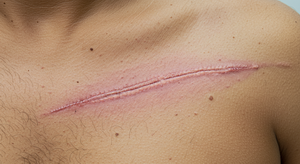 rs. Any type of tissue damage like this is going to stimulate the formation of scar tissue, so I want to figure out how to minimize the unnecessary scar formation while still allowing for a strong closure of the involved tissues. Scars are a compromise between the need for rapid healing and perfect restoration. When a tissue of the body has a tear or cut that needs to be closed back together quickly, it calls for the immune system to first pull in the garbage collectors, the macrophages (big eaters), to clear out the debris and any pathogens from the wound site. Once things are cleaned up, a type of cell called a fibroblast migrates in and lays down scar tissue. Initially, this is a sort of glue made from type III collagen. It first lays down as a glop of gel that clogs up any broken-open blood vessels to help stop bleeding and seal moisture in the body. You have probably seen this happen when you scrape a knee or arm. The gooey stuff gradually hardens if it is exposed 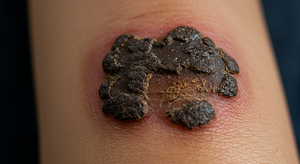 to the air and forms a scab. But if the injury is internal, so no air is getting to it, then it stays as a glob of collagen protein. This happens within a day or two at most. Perfect healing without the formation of scars would require the local cells from the injured tissue to reproduce to replace the broken, damaged cells. This is a slow process, so the body has mobile patch and repair teams that rush to the injury site and fill in the holes with patching material. So far, so good. to the air and forms a scab. But if the injury is internal, so no air is getting to it, then it stays as a glob of collagen protein. This happens within a day or two at most. Perfect healing without the formation of scars would require the local cells from the injured tissue to reproduce to replace the broken, damaged cells. This is a slow process, so the body has mobile patch and repair teams that rush to the injury site and fill in the holes with patching material. So far, so good.
What happens next is a response to the mechanical stresses on the site of injury. Both gravity and movement will pull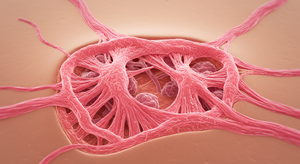 on the injury site. As this happens, the fibroblasts change into myofibroblasts, which secrete a different type of collagen (type L), which is stronger and able to contract to pull the edges of the wound together. These collagen fibers form in resistance to the pulling from movement and gravity. This makes the collagen gel matrix become more organized with tough fibers holding against the direction of action of gravity/movement, but not so organized in other directions. This is all good as far as it goes, but there are downsides. Collagen is tough and inflexible – good for stitching a wound together, but bad for normal tissue function. on the injury site. As this happens, the fibroblasts change into myofibroblasts, which secrete a different type of collagen (type L), which is stronger and able to contract to pull the edges of the wound together. These collagen fibers form in resistance to the pulling from movement and gravity. This makes the collagen gel matrix become more organized with tough fibers holding against the direction of action of gravity/movement, but not so organized in other directions. This is all good as far as it goes, but there are downsides. Collagen is tough and inflexible – good for stitching a wound together, but bad for normal tissue function.
Normal healthy tissue contains a mix of both collage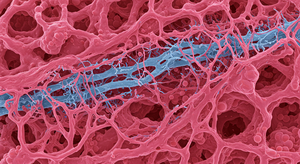 n to hold things together and in shape along with elastin, a protein that allows for flexibility and elasticity. Because it is so stiff, collagen by itself can block the blood and lymph pathways, making it difficult to bring nutrition to the area and remove waste materials. Additionally, nerve fibers can become trapped in the tough collagen, forming chronic areas of pain and dysfunction. Thirdly, the tightened collagen scar can pull on the fascial sheaths that surround every muscle and organ, causing restricted compensatory movement in tissues far away from the primary injury site, producing secondary injuries or inflammation. As wild as it may sound, a shoulder injury can end up affecting bowel function or change movement in the low back, making it prone to spontaneous injury. Basically, everything affects everything else in the body. That is why I check so many seemingly unrelated things when you come in for a visit. n to hold things together and in shape along with elastin, a protein that allows for flexibility and elasticity. Because it is so stiff, collagen by itself can block the blood and lymph pathways, making it difficult to bring nutrition to the area and remove waste materials. Additionally, nerve fibers can become trapped in the tough collagen, forming chronic areas of pain and dysfunction. Thirdly, the tightened collagen scar can pull on the fascial sheaths that surround every muscle and organ, causing restricted compensatory movement in tissues far away from the primary injury site, producing secondary injuries or inflammation. As wild as it may sound, a shoulder injury can end up affecting bowel function or change movement in the low back, making it prone to spontaneous injury. Basically, everything affects everything else in the body. That is why I check so many seemingly unrelated things when you come in for a visit.
Sometimes when you come in for a visit, I may find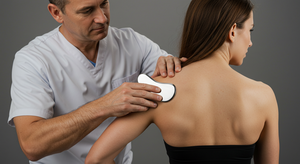 areas within muscles and tendons where there are internal scars caused by small muscle or tendon tears due to overexertion or injury. As I am feeling along the muscle pathway, I will find an area of tough grittiness. This area does not flex and move as it should and can cause problems with the function of the joint it attaches to. It can also be a source of muscle restriction that produces a loss of strength. In these cases, the use of instrument-assisted soft tissue manipulation is called for. This involves me using a stainless steel gua sha tool to rub along the gritty area in different directions. This is not a particularly comfortable process, and I will only do a little bit at a time. The idea is to break up some of this scar tissue that is limiting motion and trigger remodeling of the collagen adhesions in the muscles. It is very easy to trigger inflammation with this type of work, so limit treatment to just a couple of minutes. Typically, this soft tissue manipulation requires many sessions to break down enough adhesion to rebuild mobility. Often, I like to check the muscle after treatment to see if the movement integrates with the surrounding muscles on a brain level. We do this with muscle testing. areas within muscles and tendons where there are internal scars caused by small muscle or tendon tears due to overexertion or injury. As I am feeling along the muscle pathway, I will find an area of tough grittiness. This area does not flex and move as it should and can cause problems with the function of the joint it attaches to. It can also be a source of muscle restriction that produces a loss of strength. In these cases, the use of instrument-assisted soft tissue manipulation is called for. This involves me using a stainless steel gua sha tool to rub along the gritty area in different directions. This is not a particularly comfortable process, and I will only do a little bit at a time. The idea is to break up some of this scar tissue that is limiting motion and trigger remodeling of the collagen adhesions in the muscles. It is very easy to trigger inflammation with this type of work, so limit treatment to just a couple of minutes. Typically, this soft tissue manipulation requires many sessions to break down enough adhesion to rebuild mobility. Often, I like to check the muscle after treatment to see if the movement integrates with the surrounding muscles on a brain level. We do this with muscle testing.
Let’s switch attention to surface scars now. There are m any factors that impact how visible and lumpy surface scars appear. Genetics plays into this, with some people having the programming to form very prominent and visible scars called keloids. This is common in many tribes of people in Africa. They turn this trait into a form of beautification by creating decorative patterns of scars on their bodies. If you have this trait, treating scars to diminish their appearance may be a lost cause. However, for the rest of us, there is some hope. any factors that impact how visible and lumpy surface scars appear. Genetics plays into this, with some people having the programming to form very prominent and visible scars called keloids. This is common in many tribes of people in Africa. They turn this trait into a form of beautification by creating decorative patterns of scars on their bodies. If you have this trait, treating scars to diminish their appearance may be a lost cause. However, for the rest of us, there is some hope.
Scars happen for many reasons – some accidental, but 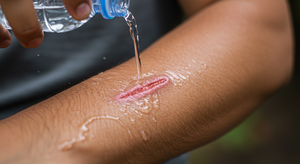 more often as a consequence of surgery. Once the skin integrity has been broached, chemical signals are released at the damage site that attract the macrophage cleanup crew and then the fibroblasts that glue the edges of the wound together. The ideal situation is to lay down just enough collagen to act like sutures to hold the wound edges together, but with enough open structure for normal healthy cells to lay down proper skin cells and protein underneath that which contains stretchy elastin instead of the typical dense hard scar collagen. This means slowing down the fibroblast action enough to allow the infiltration of new blood vessels and repair/replacement cells. One of the factors that influences this is the hydration of the tissue involved. Nature figured out that the more dehydrated the injured tissue due to loss of blood supply, the more quickly an emergency bandage was needed. So less hydration of the wound site causes faster fibroblast activity and therefore denser/thicker scar formation. more often as a consequence of surgery. Once the skin integrity has been broached, chemical signals are released at the damage site that attract the macrophage cleanup crew and then the fibroblasts that glue the edges of the wound together. The ideal situation is to lay down just enough collagen to act like sutures to hold the wound edges together, but with enough open structure for normal healthy cells to lay down proper skin cells and protein underneath that which contains stretchy elastin instead of the typical dense hard scar collagen. This means slowing down the fibroblast action enough to allow the infiltration of new blood vessels and repair/replacement cells. One of the factors that influences this is the hydration of the tissue involved. Nature figured out that the more dehydrated the injured tissue due to loss of blood supply, the more quickly an emergency bandage was needed. So less hydration of the wound site causes faster fibroblast activity and therefore denser/thicker scar formation.
A recent scar repair innovation has been the use of s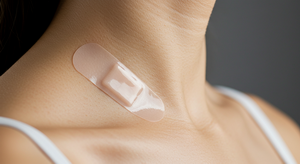 ilicone bandages that prevent the wound from drying out. This has been found to reduce the visibility and thickness of the scar tissue formation. Because of the slowing down of the emergency repair fibroblasts, the use of silicone bandages takes quite a long time – often several months. Interestingly, folks are finding that the use of silicone bandages helps even with old scars. As tissues age, they have to be replaced. Normally they are replaced with the same tissue type as was there before, but in this case the improved hydration created by the bandage reduces the fibroblast activity allowing more normal skin cells to infiltrate the area. ilicone bandages that prevent the wound from drying out. This has been found to reduce the visibility and thickness of the scar tissue formation. Because of the slowing down of the emergency repair fibroblasts, the use of silicone bandages takes quite a long time – often several months. Interestingly, folks are finding that the use of silicone bandages helps even with old scars. As tissues age, they have to be replaced. Normally they are replaced with the same tissue type as was there before, but in this case the improved hydration created by the bandage reduces the fibroblast activity allowing more normal skin cells to infiltrate the area.
Other options for helping healthy skin to repair with 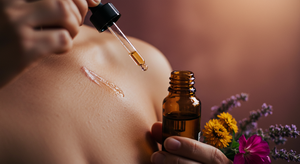 little scar formation are the use of essential oils to both nourish and protect the healing skin. These oils provide both antibacterial and antifungal properties to keep the wound clean and reduce inflammation as well as providing vitamins and signaling molecules that speed up normal healing. The essential oil with the most research behind it is lavender essential oil, functioning as an antibiotic, antioxidant, and antiseptic as well as promoting tissue regeneration through stimulating the growth factor TGF-B. The next best researched are helichrysum oil and geranium oil for their ability to stimulate healing. Frankincense has a long history of helping prevent scar formation. Tea tree oil is excellent for killing bacteria in wounds. little scar formation are the use of essential oils to both nourish and protect the healing skin. These oils provide both antibacterial and antifungal properties to keep the wound clean and reduce inflammation as well as providing vitamins and signaling molecules that speed up normal healing. The essential oil with the most research behind it is lavender essential oil, functioning as an antibiotic, antioxidant, and antiseptic as well as promoting tissue regeneration through stimulating the growth factor TGF-B. The next best researched are helichrysum oil and geranium oil for their ability to stimulate healing. Frankincense has a long history of helping prevent scar formation. Tea tree oil is excellent for killing bacteria in wounds.
Essential oils are generally too strong to use directly on the skin and need to be diluted in a carrier oil. One such carrier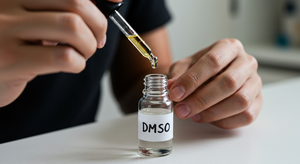 oil that also has great scar-reducing properties is rose hip oil. This is believed to be because of its high levels of vitamin C, fatty acids, and vitamin A, as well as vitamins B1 and B2. It does a nice job of reducing redness and swelling just by itself. Another carrier I especially like is DMSO as it does a fantastic job of carrying the essential oil down into the tissue. It also has antimicrobial and antifungal action itself as well as inhibiting the excess scar tissue formation that happens in keloid scars. I have created a blend of these essential oils in a base of rose hip oil and DMSO for Ellen to treat the post-surgical scar on her neck where the skin graft for her eyelid came from. So far, things are looking very good. oil that also has great scar-reducing properties is rose hip oil. This is believed to be because of its high levels of vitamin C, fatty acids, and vitamin A, as well as vitamins B1 and B2. It does a nice job of reducing redness and swelling just by itself. Another carrier I especially like is DMSO as it does a fantastic job of carrying the essential oil down into the tissue. It also has antimicrobial and antifungal action itself as well as inhibiting the excess scar tissue formation that happens in keloid scars. I have created a blend of these essential oils in a base of rose hip oil and DMSO for Ellen to treat the post-surgical scar on her neck where the skin graft for her eyelid came from. So far, things are looking very good.
So we have reviewed both internal scarring from mus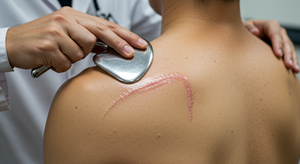 cle micro tears as well as surface scars coming from injury or surgery. I discussed using soft tissue manipulation to soften and break up the internal adhesion-type scars and discussed both the use of silicone bandages as well as using essential oils for treating surface scars. The best time to treat any scar is just as it starts to form to promote a more healthy tissue in its place. But even with old scars, some improvement is possible with the silicone and essential oils. Hopefully, you don’t ever need this information, but if you do, you now have it. cle micro tears as well as surface scars coming from injury or surgery. I discussed using soft tissue manipulation to soften and break up the internal adhesion-type scars and discussed both the use of silicone bandages as well as using essential oils for treating surface scars. The best time to treat any scar is just as it starts to form to promote a more healthy tissue in its place. But even with old scars, some improvement is possible with the silicone and essential oils. Hopefully, you don’t ever need this information, but if you do, you now have it.
Take care,
David
Ellen
Last week Ellen went back to visit her eye surgeon, pos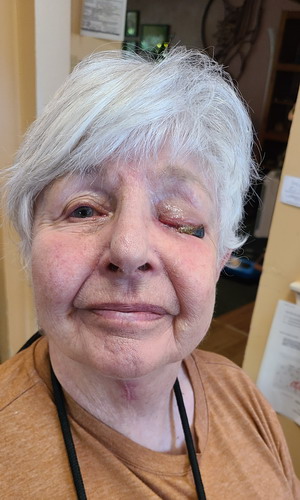 sibly to have the graft opened so she could see out of her left eye again. But he took one look at the eye and decided that it needed to heal a bit more. The eye was still scabbed over in spite of our using a hot wet towel on it twice a day. Well it has been a week now and bit by bit the scab has been coming off. Now it is about half the size it was and the tissue under it looks really nice! sibly to have the graft opened so she could see out of her left eye again. But he took one look at the eye and decided that it needed to heal a bit more. The eye was still scabbed over in spite of our using a hot wet towel on it twice a day. Well it has been a week now and bit by bit the scab has been coming off. Now it is about half the size it was and the tissue under it looks really nice!
When is the best time to eat?
Recent research studying circadian rhythm and sleep cycles has determined that those who eat the majority of their daily calories before 8 to 10 hours after the midpoint of their natural sleep cycle had less obesity and metabolic syndrome. For example if you naturally sleep from 10pm to 6am then you would want to eat more than 50% of your daily calories before noon.
More
___________________________
“Joy comes from discovering new parts of self and manifesting them as new relationships with life. We are our greatest joy.“
~David DeLapp
_____________________________________
Common drug found to speed up aging and dementia
Anti-cholinergic medications (like Benadryl) when used frequently have been found to induce muscle function problems and speed dementia. People use these for all sorts of reasons, like bladder weakness, motion sickness, allergy reactions, and so on.
More
____________________________
“No human can see the truth. To see the truth you have to see things from every angle, situation, and condition simultaneously. The most a human can every have is a perception. “
~David DeLapp
________________________________________
Negative thinking makes asthma worse
An interesting study following people after their first d iagnosis of asthma found that the worse their expectations about the impact asthma would have on their life, the worse the actual outcomes were in the progression of their disease. iagnosis of asthma found that the worse their expectations about the impact asthma would have on their life, the worse the actual outcomes were in the progression of their disease.
More
________________________
“Your opinion is important when you have creative control over what is happening, if you don’t then your opinion means nothing. If we are not the creator, then what is just is. It is not for us to judge.“
~David DeLapp
|

